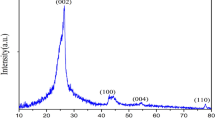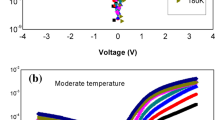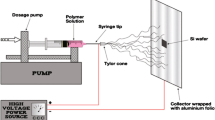Abstract
The possible current-conduction mechanism (CCMs) of the Au/CoSO4-PVP/n-Si junctions was investigated using temperature-dependence current–voltage (I–V) experiments over 100–360 K. The experimental results showed that the value of BH increases approximately linearly with increasing temperature. Such positive temperature coefficient (α = ΔΦB0/ΔT) is in agreement with the reported negative temperature coefficient of the bandgap of Si (= − 0.473 meV/K). The (nap−1−1) vs q/2kT curves have different characters in two temperature ranges due to having separate two barrier distributions. The ρ2 and ρ3 values obtained from intercept and slope of these curves as 0.521 V and 0.011 V for 240–360 K temperature range and 0.737 V and 0.004 V for the 100–220 K range. This results show that the high temperature region with smaller ρ2 and larger ρ3 voltage deformation coefficients has a wider and greater of the barrier height distribution than the second region. As an evidence for the Gaussian distribution, the ΦB0 and standard deviation (σ0) were derived from the intercept and slope of the ΦB0-q/2kT curves as 1.14 eV and 0.163 V at high temperatures and 0.62 eV and 0.088 V at low temperatures. The Richardson constant obtained as 102 A/cm2K2 for 240–360 K temperature range using standard deviation value which is similar to the theoretical Richardson constant value of silicon (112 A/cm2K2). For each temperature, the profile of Nss vs (Ec–Ess) was provided using the voltage-dependent effective barrier height (Φe) value. It was observed that these surface conditions decreased with increasing temperature.









Similar content being viewed by others
References
D.A. Zakheim, W.V. Lundin, A.V. Sakharov, E.E. Zavarin, P.N. Brunkov, E.Y. Lundina, A.F. Tsatsulnikov, S.Y. Karpov, Semicond. Sci. Technol. 33, 1–8 (2018)
O. Pakma, N. Serin, T. Serin, Ş. Altındal, J. Appl. Phys. 104, 014501 (2008)
M. Gutowski, J.E. Jaffe, C.L. Liu, M. Stoker, R.I. Hegde, R.S. Rai, P.J. Tobin, Appl. Phys. Lett. 80, 1897–1899 (2002)
Ş. Altındal, Ö. Sevgili, Y. Azizian-Kalandaragh, J. Mater. Sci. Mater. Electron. 30, 9273–9280 (2019)
A. Tataroglu, S. Altindal, Y. Azizian-Kalandaragh, J. Mater. Sci. Mater. Electron. 31, 11665–11672 (2020)
I. Taşçıoğlu, Ö. Sevgili, Y. Azizian-Kalandaragh, Ş. Altındal, J. Electron. Mater. 49, 3720–3727 (2020)
M. Hussein Al-Dharob, H. Elif Lapa, A. Kökce, A. Faruk Özdemir, D. Ali Aldemir, Ş. Altındal, Mater. Sci. Semicon. Process. 85, 98–105 (2018)
S. Alptekin, Ş. Altındal, J. Mater. Sci. Mater. Electron 30, 6491–6499 (2019)
L.A. Lipkin, J.W. Palmour, IEEE Trans. Electron. Dev. 46, 525–532 (1999)
R.T. Tung, Mater. Sci. Eng. Rev. 35, 1–138 (2001)
B.P. Lakshmi, M.S.P. Reddy, A.A. Kumar, V. Rajagopal Reddy, Curr. Appl. Phys. 12, 765–772 (2012)
P. Singh, S.N. Singh, M. Lal, M. Husain, Sol. Energy Mater. Sol. Cells 92, 1611–1616 (2008)
Y.P. Song, R.L. Van Meirhaeghe, W.H. Laflere, F. Cardon, Solid-States Electron. 29, 633–638 (1986)
S.K. Chand, J. Appl. Phys. A 63, 171–178 (1996)
M.K. Hudait, K.P. Venkateswarlu, S.B. Krupanidhi, Solid-State Electron. 45, 133–141 (2001)
V. Rajagopal Reddy, V. Manjunath, V. Janardhanam, C.H. Leem, C.J. Cho, J. Electron. Mater. 44, 549–556 (2015)
H.C. Card, E.H. Rhoderick, J. Phys. D 4, 1589–1601 (1971)
J.P. Sullivan, R.T. Tung, M.R. Pinto, W.R. Graham, J. Appl. Phys. 70, 7403–7424 (1991)
Ç.Ş. Güçlü, A.F. Özdemir, Ş. Altındal, Appl. Phys. A 122, 1032 (2016)
M. Sze, Physics of Semiconductor Devices, 2nd edn. (Wiley, New York, 1981)
B.L. Sharma, Metal-Semiconductor Schottky Barrier Junctions and Teheir Applications, 2nd edn. (Plenum Press, New York and London, 1984)
E.H. Rhoderick, R.H. Williams, Metal Semiconductor Contacts, 3rd edn. (Oxford press, Oxford, 1988)
V.R. Reddy, V. Janardhanam, C.H. Leem, C.J. Choi, Superlatt. Microstruct. 67, 242–255 (2014)
F.A. Padovani, R. Stratton, Solid State Electron. 9, 695–707 (1996)
S. Chand, J. Kumar, Semicond. Sci. Technol. 11, 1203–1208 (1996)
R.T. Tung, Phys. Rev. B 45, 13509 (1992)
E. Arslan, Y. Şafak, Í. Taşçıoğlu, H. Uslu, E. Özbay, Microelectron. Eng. 87, 1997–2001 (2010)
R. Tung, Appl. Phys. Lett. 58, 2821 (1991)
R.F. Schmitsdorf, T.U. Kampen, W. Mönch, Surf. Sci. 324, 363–378 (1995)
J.H. Werner, H.H. Gütter, Appl. Phys. 69, 1522–1532 (1991)
Author information
Authors and Affiliations
Corresponding author
Additional information
Publisher's Note
Springer Nature remains neutral with regard to jurisdictional claims in published maps and institutional affiliations.
Rights and permissions
About this article
Cite this article
Elamen, H., Badali, Y., Güneşer, M.T. et al. The possible current-conduction mechanism in the Au/(CoSO4-PVP)/n-Si junctions. J Mater Sci: Mater Electron 31, 18640–18648 (2020). https://doi.org/10.1007/s10854-020-04406-3
Received:
Accepted:
Published:
Issue Date:
DOI: https://doi.org/10.1007/s10854-020-04406-3




